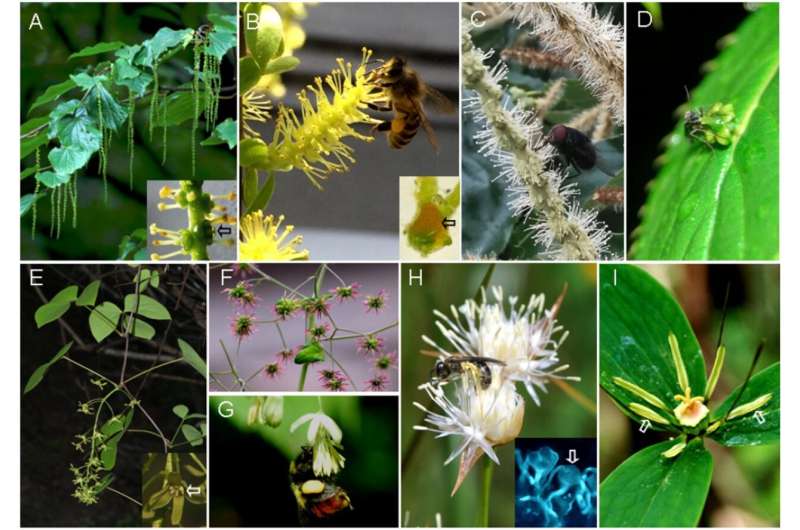This article has been reviewed according to Science X's editorial process and policies. Editors have highlighted the following attributes while ensuring the content's credibility:
fact-checked
trusted source
proofread
90% of flowering plant species found to rely on animal pollinators

Pollen of flowering plants can be dispersed by animals, wind or even by water. In assessing pollination modes, a fundamental question is how many flowering plants are pollinated by animals. Although the question has been raised previously, an accurate estimation remains elusive.
Early estimates of the proportion of animal-pollinated species were rough, varying from 2/3 to over 80%. The latest and widely accepted answer was 87.5%, proposed in 2011, based on average proportions of animal-pollinated species from around 40 communities, involving a sample of no more than 1% species of flowering plants, rather than tallying taxa exhaustively.
A recent study published in the journal National Science Review sought to address this issue. This study was led by Prof. Shuang-Quan Huang, Director of Institute of Evolution and Ecology, School of Life Sciences, Central China Normal University. Prof. Huang has been dedicated to pollination biology for decades, since his graduate studies from 1993.
Another issue confronted by Prof. Huang's team was that pollination modes of some taxa were misidentified or misunderstood, causing problems in conservation of truly animal-pollinated plants, as well as in tallying pollination modes. For example, Tetracentron sinense (Trochodendraceae), a tree endemic to central China, has green pendulous inflorescences (spikes) and was considered to be wind pollinated.
However, the team observed in the field that the small nectar-rich flowers were effectively pollinated by small bees. "Given that pollination modes in over ten thousand of flowering species have been recorded since Darwin's era, it is time for us to give more accurate estimation of the proportion through data counting," says Prof. Huang. "This might be a challenge and bring a lot of controversy, but will be insightful," say Prof. Armbruster and Prof. Renner, who were intrigued and had joined the discussion of this topic three years before.
Team member Drs. Ze-Yu Tong et al., together with the group leader Prof. Shuang-Quan Huang, and co-workers Prof. Scott Armbruster and Prof. Susanne Renner, sought to make a more complete tally of animal-pollinated flowering plants. They surveyed data of pollination modes from thousands of publications and extracted abiotically pollinated cases as well as ambophilous (using both biotic and abiotic agents for pollination) ones.
They then evaluated these data in the context of two global mega-databases (GBIF, WFO) at species, genus, and family levels, obtaining by subtraction direct estimates of the proportion of biotic pollination across all angiosperms.
The team found that 64-68% families, 88% genera and 90% species of flowering plants relied on animal pollination. "This global survey has definitely provided a new view and relatively an accurate estimate of the importance of pollinators in flowering-plant reproduction on our planet," Prof. Huang says.
The researchers also re-calculated the latest and most widely adopted previous estimate based on community sampling. After correcting for variation in sample sizes (not performed previously), the original estimate of 87.5% changed to 89.5%. "The recalculation of the community dataset matches well with the direct-tally-and-subtraction approach; this is presumably not a coincidence," says Prof. Armbruster.
Answering the fundamental question of how many species of flowering plants are animal-pollinated, is critical for pollinator conservation and management in both natural and agricultural ecosystems. The new calculation of 90% flowering plant species relying on animal pollination will pave the way for better understanding to the critical role that pollinators play in the health of ecosystems on planet Earth, especially in light of ongoing pollinator declines globally.
More information: Ze-Yu Tong et al, New calculations imply that 90% of flowering plant species are animal-pollinated, National Science Review (2023). DOI: 10.1093/nsr/nwad219
Provided by Science China Press





















